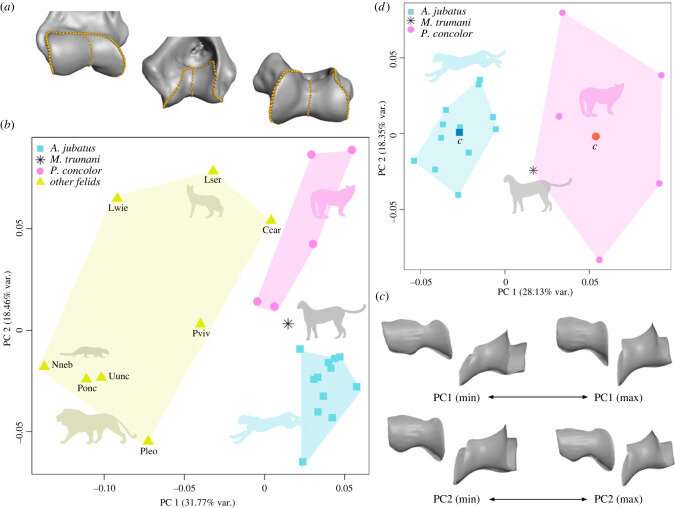This article has been reviewed according to Science X's editorial process and policies. Editors have highlighted the following attributes while ensuring the content's credibility:
fact-checked
peer-reviewed publication
proofread
Researchers uncover new characteristics of the extinct American cheetah 'Miracinonyx'

The Miracinonyx trumani, commonly known as the American cheetah, lived in North America more than 13,000 years ago. Despite its name, recent studies conducted at the University of Malaga have revealed that it is more similar to the cougar than the living cheetah, but with its own characteristics that make it a unique species, of which there is no modern analogous feline today.
Paleontologists at the UMA, together with researchers at the University of Valladolid and the University of Wisconsin-Madison (U.S.), have cast light on the characteristics of this extinct feline, mainly by studying its hunting strategy, which has been the subject of discussion in recent decades.
Study of its hunting strategy
This way, by analyzing its skeleton, the experts have proved that the Miracinonyx trumani, despite having long and light legs, was not as prepared as once thought to run after its preys, like the Old World cheetahs.
The results of the study, published in the scientific journal Biology Letters, also revealed that the claws of the Miracinonyx were retractable and it had the ability to grapple with its preys, like the rest of the felines, with the exception of the cheetah.
"Although in appearance they were very like modern cheetahs, their way of hunting was more similar to that of a cougar," says Borja Figueirido, scientist of the Paleontology Area of the UMA, and main author of the study.
The experts focused specifically on the elbow-joint, which allows them to know whether the animal is adapted to hunt by holding its preys with its forelimbs or is able to chase them at high speed.
The humerus of the Miracinonyx was oval and elongated at the end closest to the elbow, which means that its forearm bones were further apart and, therefore, it had the ability to hunt its preys by grasping them, as cougars do.
"The case of cheetahs is really unusual; in a few seconds they can reach nearly 100 kilometers per hour. They are the supercars of the savanna," says Figueirido.
This is not the case of the Miracinonyx. Although it had greater manipulation capacity with its forelimbs, its physiognomy prevented it from reaching a speed similar to that of the living cheetah. It was not, therefore, such a sprinting predator, says Alberto Martín Serra, paleontologist at the UMA, and co-author of the paper.
Analysis of its bones
To reach this conclusion, the scientists examined a skeleton of Miracinonyx found in a chasm in Wisconsin and compared it with the species of other modern felines, such as cougars, lions or lynxes.
"The detailed study of the bones was conducted at the UMA. What we did was to scan in 3D the humerus of living felines and digitalize homologous points to quantify its form. The fossil was scanned using CAT scan at the University of Wisconsin-Madison," explains Figueirido.
Study of its brain architecture
Another recent study by this research team of the University of Malaga, published in the scientific journal iScience, corroborates this hypothesis. The paleontologists analyzed if the brain architecture of Miracinonyx was similar to that of cheetahs, and results evidenced, again, clear differences between them.
Using 3D technology, the scientists virtually filled the intracranial space where the brain is housed, obtaining an endocast of the Miracinonyx trumani's brain surface, which they compared to living cheetahs and cougars.
The Miracinonyx's brain surface turns out to be more like the cougar's than the cheetah's: the Old World American cheetah was not cognitively prepared to hunt by high-speed chasing, among other things, because it had an underdeveloped nasal sinus, like cougars.
"The Miracinonyx was probably an intermediate version between the cheetah and the cougar," says Figueirido, who highlights that its "particular" way of hunting "is not currently represented in nature."
After these first two studies, the researchers at the University of Malaga, the University of Valladolid and the University of Wisconsin-Madison want to continue with this R&D line and study the complete forelimbs and the anatomy of the inner ear of the Miracinonyx, in order to answer the questions that remain unresolved around this unique North American fossil feline.
More information: Borja Figueirido et al, Elbow-joint morphology in the North American 'cheetah-like' cat Miracinonyx trumani, Biology Letters (2023). DOI: 10.1098/rsbl.2022.0483
Borja Figueirido et al, The brain of the North American cheetah-like cat Miracinonyx trumani, iScience (2022). DOI: 10.1016/j.isci.2022.105671
Journal information: Biology Letters , iScience
Provided by University of Malaga





















